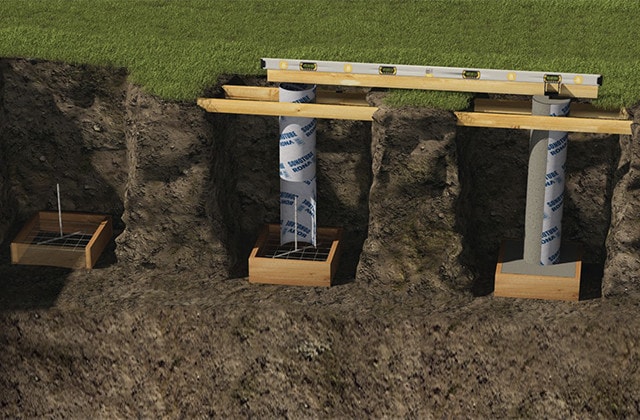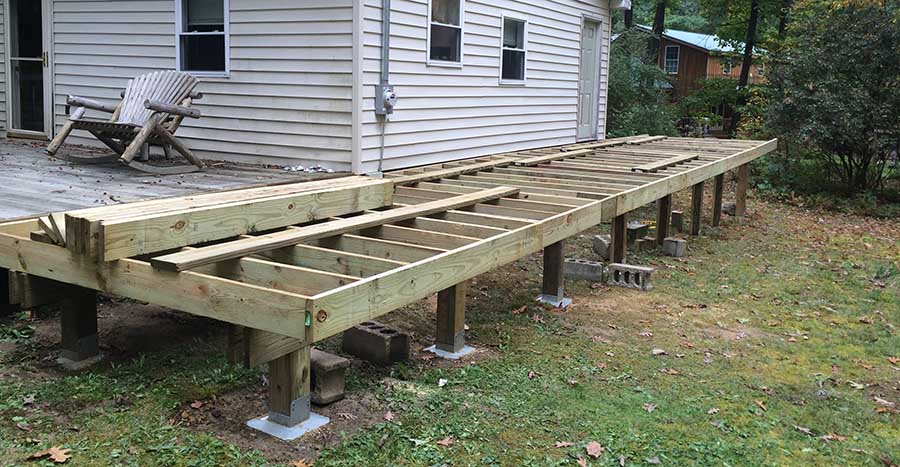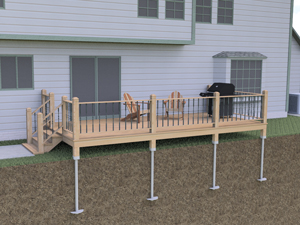Specialist Tips for Putting Up Deck Footings to Support Your Outdoor Room
When it comes to constructing a deck, one of the most important components to think about is the setup of proper footings. These grounds are the structure upon which your exterior room will certainly relax, offering security and support for years to come. What exactly does it take to install deck footings appropriately?
Significance of Appropriate Deck Grounds
Appropriate deck grounds are essential for ensuring the security and longevity of your exterior area. When constructing a deck, it is essential to take notice of the foundation on which it will certainly relax. Deck grounds provide the essential support for the entire framework and help distribute the weight uniformly - Deck Footings. Without solid and properly set up grounds, your deck may become unsteady, causing security threats and costly repair work.

In enhancement to stability, proper deck footings also contribute to the durability of your exterior room (Deck Footings). Grounds that are created and constructed to endure the components and dirt problems in your area will certainly assist stop the deck from moving or resolving over time. By making certain the footings are appropriately sized and set up, you can reduce the risk of damages to the deck structure, expanding its life expectancy and decreasing the need for costly repairs or replacements

Picking the Right Kind Of Footings
When picking the suitable sort of footings for your deck, it is important to think about variables such as soil problems, regional building codes, and the overall style of your exterior area. The type of footing you pick will certainly play a critical function in making sure the stability and long life of your deck.
One typical kind of ground is the concrete ground. Concrete footings are appropriate for the majority of soil problems and offer outstanding assistance for decks. They are typically installed below the frost line to avoid moving and settling because of freezing and thawing cycles. One more option is helical piers, which are perfect for areas with unpredictable soil or high water tables. These piers are screwed into the ground and provide solid support for the deck.
In many cases, you might need to utilize specialized grounds, such as stack footings or deep foundations, if you are building a large or multi-level deck. These grounds are designed to distribute the weight of the deck over a bigger location, making sure security and protecting against working out or sinking.
Prior to picking a kind of ground, it is important to speak with local building regulations and regulations to make sure compliance. In addition, take into consideration the design and meant use your outdoor area. Variables such as the dimension, shape, and load-bearing requirements of your deck will certainly influence the type of footing that is most appropriate.
Preparing the Ground for Footing Installation
To appropriately prepare the ground for footing setup, it is vital to evaluate the dirt conditions and take essential actions to make sure stability and sturdiness of the deck. The first step is to excavate the area where the footings will certainly be set up.
When the location has actually been dug deep into, the following action is to small the soil. This can be done using a plate compactor or by utilizing a hand meddle. Condensing the dirt assists to remove any kind of spaces or air pockets, which can lead to clearing web link up and instability in time.
After condensing the dirt, it is vital to lay a layer of crushed rock or smashed rock at the end of the excavation. This will certainly give drain and assistance to avoid water from merging around the grounds, which can bring about disintegration and instability.
Step-by-Step Guide to Installing Deck Footings
After correctly preparing the ground for footing setup, the following action is to begin the process of installing deck grounds. This detailed overview will give you with a clear understanding of just how to install deck footings for your exterior area.
Identify the area: Begin by marking the settings of the deck grounds utilizing risks and string. Guarantee that the locations straighten with the layout and format of your deck.
Dig the openings: Make use of a message opening digger or an auger to dig the holes for the footings. The deepness and diameter of the holes ought to remain in conformity with regional building regulations and the specific needs of your deck design.
Degree the openings: Utilize a degree to make certain that the openings are dug to the appropriate depth and are degree with each other. (Deck Footings)
Add gravel: Area a layer of crushed rock at the end of each hole to improve water drainage and protect against the wood from rotting.
Put the grounds: Put the footings right into the openings, making certain they are degree and plumb. Utilize a level and a measuring tape to ensure accuracy.
Safeguard the grounds: Put concrete right into the holes around the footings, loading them to the top. Use an article level to make certain the grounds remain degree as the concrete sets.
Enable time for treating: Let the concrete cure according to the official source manufacturer's instructions prior to waging the deck building.
Typical Errors to Prevent Throughout Footing Setup
One important facet to take into consideration throughout the installation of deck footings is avoiding typical errors that can endanger the security and durability of your exterior space. While deck footings might appear like a straightforward and simple component of the building and construction procedure, forgeting specific factors can lead to costly repairs and potential safety and security dangers down the line.

In addition, overlooking to set up appropriate drain measures can trigger water to gather around the grounds, causing rot, degeneration, and the ultimate weakening of the deck's foundation. Additionally, utilizing the incorrect kind of footing material or falling short to sufficiently protect the footings can endanger their architectural integrity.
To avoid these mistakes, it is vital to talk to a specialist or comply with market guidelines to ensure proper ground setup. By doing so, you can make sure the security and durability of your outdoor space, giving a safe and delightful environment for several years ahead.
Verdict
To conclude, mounting proper deck grounds is essential for the security and long life of your outside space. By choosing the ideal kind of footings and sufficiently preparing the ground, you can guarantee a solid foundation for your deck. Complying with a step-by-step overview and staying clear of common errors throughout footing setup will certainly additionally boost the durability and safety and security of your deck.
Correct deck footings are vital for making sure the stability and long life of your exterior area. The grounds serve as a connection between the deck and the ground, enabling the weight of the deck and its residents to be distributed equally into the dirt.One usual type of ground is the concrete footing. Insert the grounds: Position the grounds right into the holes, making certain they are level and plumb. Safeguard the footings: Put concrete right into the openings around the footings, filling them to the top.